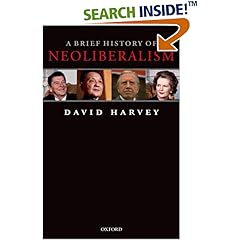For part I, click here.
To skip to part III: An Overview of A Brief History of Neoliberalism Part III
Class Power Reborn
The revival and strengthening of the upper class since Reagan and Thatcher is easily demonstrable by charting the trends of distribution of wealth, the tremendous rise in CEO compensation and the shape and size of tax laws over the last few decades. That rewarding the rich with even more power and wealth through the weakening of financial rules and tax responsibilities has become so commonplace is testament to the influence of neoliberalism on a global scale, but also as way of thinking that has invaded the public's self-image. Harvey thus relates that societies that seem to be acting with neoliberal “common sense” are not always acting for the common good. In fact, privatization on both a grand scale and at the molecular level of “personal responsibility” saps energy from the idea of common and communal good by lending credence to the idea that what is good for the individual must also be good for the community.
By capturing ideals of individual freedom and turning them against the interventionist and regulatory practices of the state, capitalist class interests could hope to protect and even restore their position...But it had to be backed up by a practical strategy that emphasized the liberty of consumer choice, not only with respect to particular products but also with respect to lifestyles, modes of expression, and a wide range of cultural practices. Neoliberalization required both politically and economically the construction of a neoliberal market-based populist culture of differentiated consumerism and individual libertarianism. (42-43)
Of course, this individual libertarianism has created contradictions in neoliberalism itself as the very real breakdown of old social orders has also liberated marginalized groups (Gays and Lesbians for example). Not surprisingly, this has led to the desire of many on the Right to replace newly won personal freedoms with authoritarianism and populist “morality.”
“Left movements,” he writes, “failed to recognize or confront, let alone transcend, the inherent tension between the quest for individual freedoms and social justice” (43). On the right, however, there was both a conscious and subconscious awareness that, in the 1970's, the tectonic cultural shifts from the left and the rising power of the finance economy begun under Nixon could be absorbed through the prism of neoliberal philosophy and economics. Neoliberals saw, in the Left's “prescriptivism,” an opportunity to gain influence by promising liberation. They thus set out to take advantage of this situation through long-term planning and concerted effort. Harvey cites the growth and influence of organizations such as the Chamber of Commerce, National Bureau of Economic Research and many other think tanks that quickly began to gain influence in Washington, in universities and in the press. Quoting Blyth, Harvey determines that by the end of the decade, “[b]usiness was learning to spend as a class” (44).
The multiple economic crises of the 1970's were, in fact, the result of capitalism being unable to provide markets for its surplus gains (there seemed to be nowhere to invest). The oil embargo of course played a role too. The U.S. agreed not to invade or harass Saudi Arabi following the OPEC rise in power provided that the Saudis would turn right back around and reinvest the petrodollars in Wall Street. The funneling of a huge amount of dollars into U.S. markets from Saudi Arabia following the oil crisis brought with it some problems. The U.S. economy was doing poorly and therefore not ripe for investment. What to do with the surplus—and surplus income always brings the danger of inflation or stagnation—became a major issue. The answer came, over the next few years, in the form of a reconstituting of international monetary policy in the World Bank and IMF. This process took several years and was the result of multiple processes and examples, and it essentially led to re-investment of the petrodollars in the form of loans to third-world nations, with Wall Street reaping enormous benefits as the middlemen. The monetary crises would also mean a great deal of restructuring at home, but in a very different form than had been practiced since the New Deal's keynsian social pact. This time the confluence of investment money would join with the allure of individualism preached by neoliberal institutions and politicians such as Reagan and Thatcher.
As stated above, the Left should be blamed for failing to counter-argue the neoliberal narrative and demonstrate the repercussions of the rise of a new class of wealthy elite. Harvey points out as well the flexibility of neoliberalism to insert itself into divergent political economic systems such as Britain and the U.S. Notions of class have always been fluid in the U.S., but in Britain they have long been associated with the aristocracy and aristocratic institutions. Thatcher's neoliberalism thus represented not a restoration of the old aristocracy, but the creation of a new one, of the London City-based financier, and in that sense did indeed liberalize England (if not Great Britain).
End of Part II.


